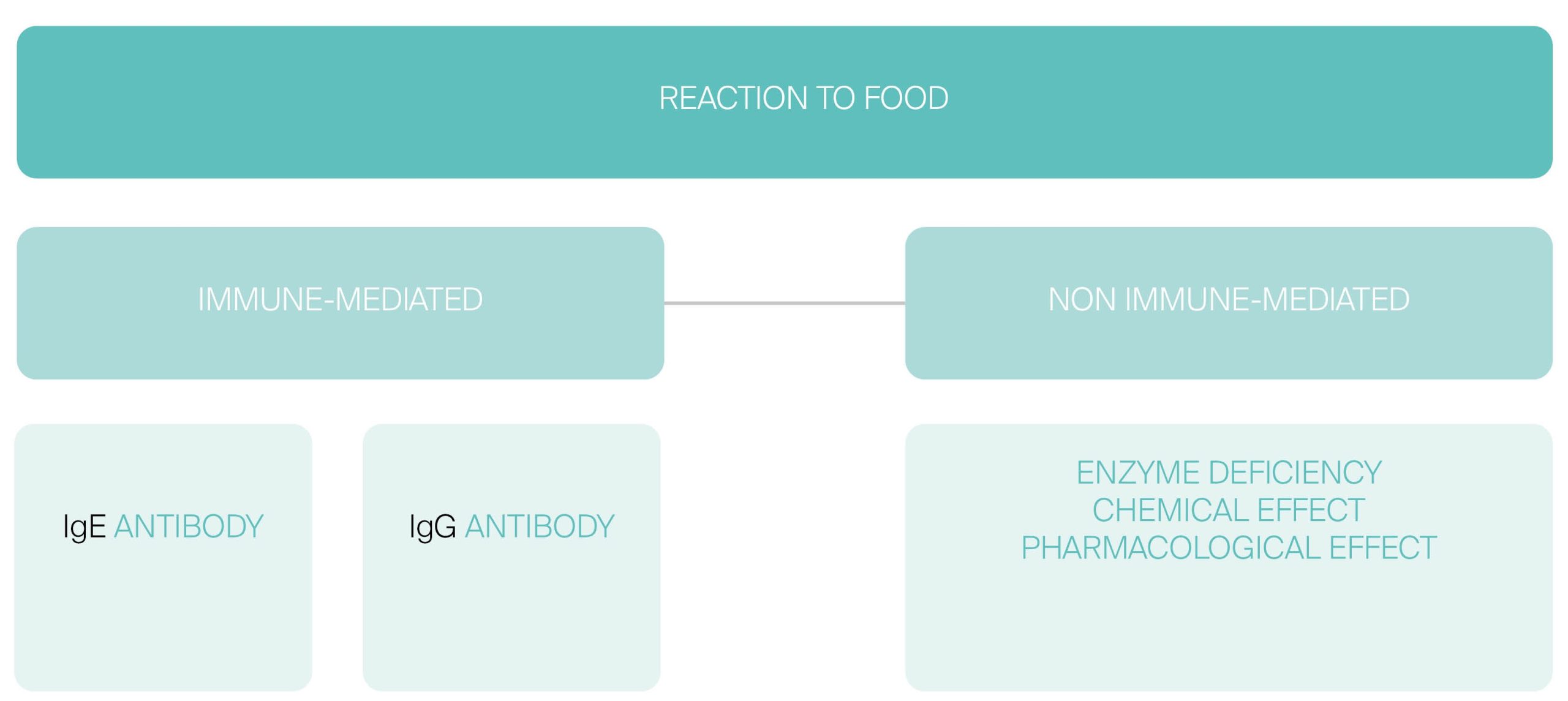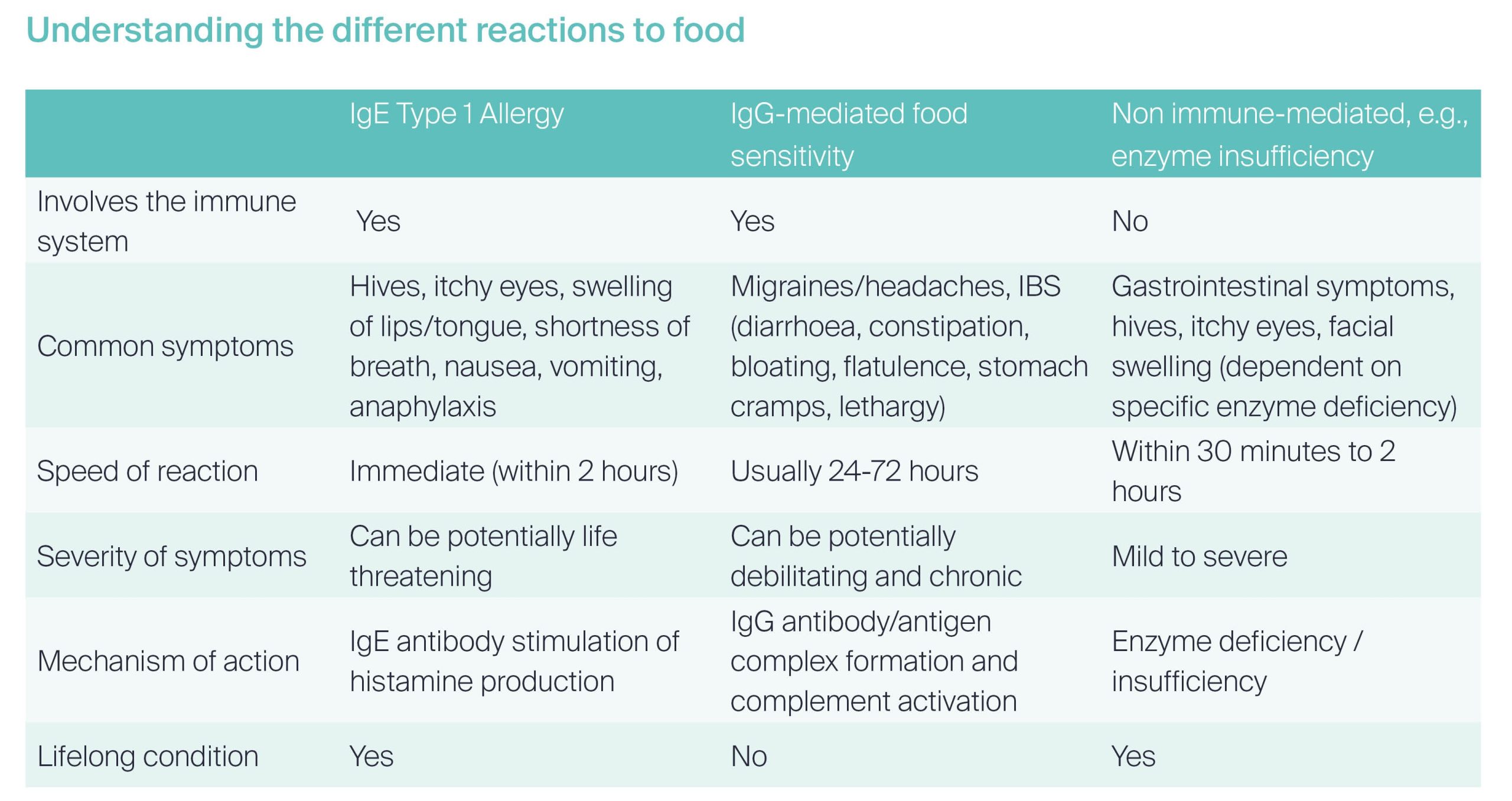What is food sensitivity?
Food sensitivity can result from your body reacting badly to certain foods.

Food sensitivities can develop as a result of an adverse delayed immune response to certain foods. Often the foods we include regularly in our diet or the foods we crave may be the ones causing us a problem.
Scientific research has shown that food sensitivity can be linked to IgG antibodies produced when these ‘problem’ foods are eaten. Normally these antibodies do not have any ill-effects, but if the immune or digestive system are not working optimally, their presence may provoke a wide range of symptoms.
Optimal gut health and digestive function are essential for maintaining good health and well-being.
The cause of food sensitivities is complex and not fully understood, but damage to the intestinal barrier wall is thought to play a role which allows undigested food proteins to pass across the gut wall barrier which provokes an elevated immune response.
The reasons for the development of food sensitivities can vary from person to person but the following factors are thought to be involved:
Some symptoms of food sensitivity, for example bloating or diarrhoea, could be due to other health issues, like coeliac disease, and it is important to see your doctor to rule these out before doing a food sensitivity test.
Many of the following symptoms can be a result of food sensitivity:
Bloating
Many people experience an improvement in symptoms and health after changing their diet based on their test results.
Like any diagnostic test, our food sensitivity tests will only produce meaningful results if you are experiencing symptoms and can help identify the problem foods by detecting food-specific IgG antibodies in your blood. Using these results as a guide, you and your healthcare professional can then adjust and plan your new diet.
After you have taken a food sensitivity test, your healthcare professional will work with you to create a diet which eliminates your problems foods, offer healthy alternatives, and guidance on how to reintroduce foods.
Typically, a customised diet will be followed for around 3 months to allow the symptoms to subside.
It is acknowledged that a “one size fits all” approach to diet and health no longer works, as our genes, biochemistry and gut microbiome are all unique to every one of us. A more personalised approach to nutrition and health, based on lifestyle, genetics and microbiome profile is required to meet the challenges of managing chronic illness in the future.
The terms ‘food allergy’, ‘food intolerance’ and ‘food sensitivity/hypersensitivity’ are often used interchangeably and this can be quite confusing.
In simple terms, they all mean that an individual has reacted to a food that has been consumed and this then manifests as symptoms. The reactions they trigger can also vary greatly.
This includes the symptoms experienced and how quickly the symptoms manifest after the food has been consumed, as well as the severity of the symptoms and how long they last, and if they are life threatening. Some of these reactions involve the immune system and some don’t.
The diagram below gives a summary of the different reactions being highlighted. Take a look at it before we go through each of them in detail. This will help you to understand that, while IgG-mediated food sensitivity is one possible immunological reaction to food, it also highlights that other types of reactions to food exist.

Immune-Mediated Reactions
Reactions that trigger an immune response are most often referred to as ‘allergies’ and occur when the body over-reacts to foods that do not usually produce a response in the majority of people. This overreaction triggers the immune system to produce antibodies to attack and neutralise the ‘foreign’ food proteins which the immune system incorrectly recognises as a threat.
Allergies are grouped into four types: I, II, III and IV. These classifications are based on which part of the immune system is activated and how long it takes for a reaction to occur. The two types of allergy that are most often associated with adverse reactions to food are:
Type I Allergy
Also known as IgE-mediated allergy/type I hypersentivities / true allergy. These reactions are characterised by the production of IgE antibodies and the release of histamine and other chemical mediators, upon exposure to an allergen (e.g., peanuts and shellfish).
They are responsible for the ‘immediate-onset’ of symptoms that can occur within seconds or minutes following ingestion of certain foods. Symptoms often associated with a classic ‘allergic response’ includes rashes, sneezing, difficulty breathing, and anaphylactic shock. It is usually obvious which foods are responsible for a food allergy and these have to be avoided for life.
Type III Allergy
Also known as IgG-mediated allergy/food-hypersentivity. These reactions are characterised by the production of IgG antibodies and the gradual formation of antigen/antibody complexes which are deposited in tissues, leading to an inflammatory response.
This type of immune reaction results in ‘delayed-onset’ of symptoms which can occur several hours or days after foods are ingested. It is possible to eliminate the offending food(s) from the diet for a short periods of time and then gradually reintroduce them when symptoms have improved.
Non Immune-Mediated Reactions
Reactions that do not produce an immune response are often referred to as ‘food intolerances’. They can be caused by reactions to certain chemicals/additives found in food or, more commonly, due to enzyme deficiencies:
Enzyme Insufficiency/Deficiency
Lactose Intolerance
Histamine Intolerance

To help us understand these varying reactions, it can be helpful to have some basic knowledge of the immune system and how it works. The immune system is made up of various organs, cells and proteins and its role is to protect the body from harmful substances, germs, pathogens, fungi, and cell alterations that can result in illness.
Essentially, the main functions of the immune system are:
The immune system can be activated by substances that it doesn’t recognise as being a part of the body. Common examples include proteins found on the surfaces of microbes, such as bacteria, fungi, and viruses and these are referred to as antigens.
Receptors on the immune cells attach to these antigens and this then triggers an immune reaction, which includes the production of antibodies. Antibodies can then help to neutralise the microbes so they can’t multiply and cause illness.